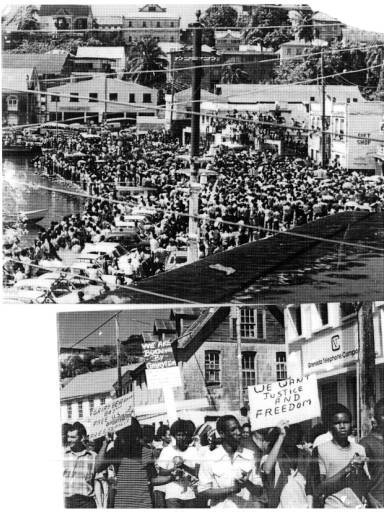
In November 2001, at a short ceremony at Marryshow House, Alister Hughes declared his commitment to donate all documentation in the Cynthia Hughes Collection to the University of the West Indies, through the University Centre at Marryshow House.
The Cynthia Hughes Collection comprises an accumulation of Grenadian artifacts, historical books, articles and documents relating to Grenada and the Caribbean; writings of Alister and Cynthia Hughes, including the Grenada Newsletter.
The Grenada Newsletter is a printed news report, which was produced and published by Alister and Cynthia Hughes from 1973 to 1994, comprising 21 volumes of newsprint. It is considered to be the most comprehensive source of information on Grenada's recent history during a crucial period of the island's development. It spans the period immediately preceding Independence; Independence; the 1979 armed take-over by the People's Revolutionary Government; the 4 years of revolutionary rule; the 1983 assassination of Prime Minister Maurice Bishop, members of his Cabinet and supporters; intervention of Grenada by U.S. Armed Forces; the trial of the '17 accused'; restoration of law, order and democratically elected government.

Grenada has the singular distinction among British Caribbean nations, and perhaps also worldwide, of not fighting to gain independence, but instead fighting to resist it! Past the peripherals, however, the growing national mood within Grenada, in the months preceding Independence in 1974 was marked by a build-up of disturbance, resistance and militancy throughout Grenada. Disparate groups, including trade unions, Chamber of Commerce, church groups, students, united in a common call for "meaningful Independence" rather than the "meaningless Independence" which Grenada's Premier E. M. Gairy was stubbornly putting in place.
Grenada was featuring almost daily in Caribbean news. But availability of credible news out of Grenada was wanting.
In July 1973, Seal Coon of Jamaica's Gleaner newspaper suggested to Alister Hughes that he produce a weekly newsletter on Grenada, which would be "purely factual, about 500 words long".
Within a month of this suggestion, on 17th August, 1973, the first issue of Grenada Newsletter was produced and mailed to its first subscriber, The Jamaica Gleaner.
Events in Grenada in the first months of the Grenada Newsletter's existence made big news and called more than ever, for professional journalism. Lines were drawn. The world needed balanced, measured credible reporting.
November 18, 1973 has been recorded in Grenada's history books as " Bloody Sunday".
On the eve of an island-wide 'shut down', planned by the popular New Jewel Movement 'to save Grenada from total destruction' under Gairy's administration,1 six leading NJM members, Maurice Bishop, Unison Whiteman, Kenrick Radix, Selwyn Strachan, Simon Daniel, and Hudson Austin, were brutally beaten by regular police, headed by Inspector Innocent Belmar, and assisted by 'Police Aids', the official name for Gairy's infamous 'Mongoose Gang'. They were then arrested, jailed and later hospitalized. In so doing Gairy unwittingly made living martyrs of his opposition and threw the protest into high gear. 22 organizations within Grenada, named The Committee of 22, staged an island-wide strike, which was only called off when Gairy met their demands for the disbandment of his 'Police Aids' and the establishment of a Commission of Inquiry (the Duffus Commission) into the operation of justice in Grenada.
Gairy's characteristic reneging on these promises meant that within weeks, by January 1974, Grenada was again locked down by a general strike. Chanting demonstrators voiced their protest "Gairy must go! Gairy must go". Grenada's 1st Governor, Hilda Bynoe resigned and moved to Trinidad. Gairy stayed. The demonstrations continued, as did the people's demands.
In quick succession, "Bloody Sunday" of November 1973 was followed by "Bloody Monday", January 21. On that day, about 500 of the disbanded 'Police Aids', assisted by Grenada's Royal Police Force unleashed a reign of terror, this time, on about 6,000 demonstrators on St George's Carenage. Sections of the demonstrators, mainly women and children took refuge within the Seamen & Waterfront Workers Union Headquarters, Otway House on the Carenage. The Police and 'Aids' succeeded in ending the demonstrations, while causing serious injury to several demonstrators, initiating the looting of several business places in St George's.2 Rupert Bishop, father of NJM's Maurice Bishop and a former member of Gairy's political party was shot and killed. He "died while protecting school children from the guns of Grenada's Police".3 Alister Hughes, reporting on the demonstrations, and witnessing the killing and ensuing mêlée, escaped a similar fate literally on a whim. The chance demand of a policeman to Hughes' assailant to spare his life "He's a good man!" !!! Within hours, together with his wife, Cynthia, he fled Grenada and spent the next four months in a self imposed and life preserving exile in Grenada's sister isle, Carriacou.
Less than 3 weeks after "Bloody Monday", on February 7th, still shrouded in shock and gloom, and with no electricity, Grenada was declared independent. Eric Matthew Gairy took his place as the island's first Prime Minister. The symbolic, "meaningless Independence" with flag raising and anthem singing was achieved. A pyrrhic victory. So ironic for an island whose emblem reads Clarior e Tenebris: Lighter out of Darkness.
A second irony, relevant to this paper is the fact that these historic events and truly journalistic gems, which should make up the first volume of the Grenada Newsletter's 21 volumes, have vanished from the Cynthia Hughes Collection. Enquiries so far futile, continue to be sent to the first subscribers in the hope that this valuable volume can be re-assembled over time.
What remains, as a testimony to the events of Bloody Monday is Alister Hughes' chilling account, on tape, which was spirited away out of Otway House, minutes before the Police and Mongoose Gang stormed the building, beat up and dispersed the crowd inside and seized all recording and transmission equipment. The tape was later aired on Radio 610, and then on to other Caribbean stations as testimony to the horrors of Grenada's Bloody Monday.
Alister Hughes' exemplary journalism was duly noted and awarded that same year, by the Caribbean Publishers and Broadcasters Assoc. for his "outstanding coverage of the disturbances prior to Grenada's Independence".
Seal Coon's charge to Alister Hughes was specific to the person. Perhaps the only choice for Seal Coon's suggestion, for the production credible weekly reports out of Grenada at that time. From the late 60's Hughes had begun channeling his writings and knowledge of Grenada into journalism and broadcasting. On the invitation of Ken Gordon of the Trinidad Express, he began writing a news column for that newspaper. Gordon was 'confident that his matter-of-fact candour would provide the type of reporting that was necessary in covering the contortions of the Gairy era'.4 By 1973, his syndicated column had 15 subscribers in the Caribbean, the US, Canada, UK and France. He was correspondent for various wire services such as CANA, UPI, and AFP, and radio reporter for several Caribbean radio stations including 610 Radio, Radio Trinidad, CANA Radio, and Radio Antilles. The voice of Alister Hughes was well known as the voice for Caribbean news, and particularly for news on troubled Grenada.
From this strong journalistic base of regular news reports, the Grenada Newsletter expanded. In the early years, the weekly newsletter contained less than 5 news items per issue. No more than 2 - 4 pages.
A random Newsletter of 1975 contained the following stories:
The publication was devoid of gloss and glamour. No frills! At inception, it predated desk-top publishing as we know it. In fact its facilities were at best, primitive! For many years, it was typewritten on a manual Hermes typewriter. A museum piece Illustrations were free hand. In the '80s the producers moved to an electric typewriter and a Gestetner for reproduction. Grenada Newsletter went into the computer age after the 1983 intervention, with an Apple Macintosh. Great for graphics - all of 512 K! - and a dot matrix printer. The Grenada Newsletter never knew of colour graphics. But beauty was never the objective! The entire Grenada Newsletter staff: owners, editors, proofreaders, graphic designers, printers, reporters, messengers, and front office from 1973 - 1989 consisted of 2 persons: Alister and Cynthia Hughes. After Mrs Hughes' death in 1989, and for the next 5 years, Alister Hughes was the sole editor, with limited secretarial and production assistance. In spite of what seem like daunting limitations and conditions, the Grenada Newsletter was consistently produced, with no 'spell check', and minimal 'flykees'.
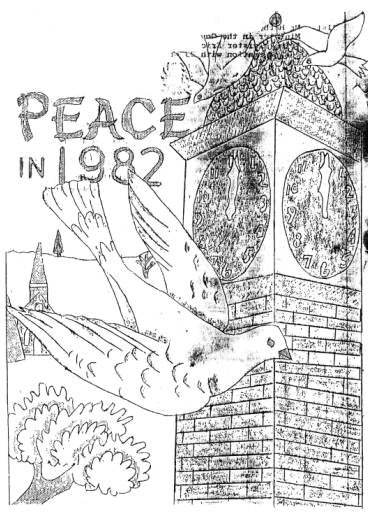
Intimate knowledge of Grenada's political history allowed Grenada Newsletter to report on current news, while giving background information and earlier relevant events. Through their choice of news-items and flashbacks, its editors were able to point their readers to the affairs in Grenada that they wished to highlight.
Lead article in the Newsletter of 28 November 1974 reported on the Leader of the Opposition, H A Blaize's charge that $1.2M EC British Grant funds had been 'diverted' into unauthorized channels by Grenada's government under Prime Minister Gairy and Minister of Finance, George Hosten. "It's the same combination, of Gairy and Hosten playing havoc with government financing". And again, they "just can't keep their heads straight when it comes to money". Though this was a statement quoted verbatim from Blaize, it suggests the Grenada Newsletter's sympathy. For the uninitiated into Grenada's history, the Newsletter then launched into a recount of the 1962 Commission of Enquiry into the Control of Public Funds, dubbed 'Squandamania', quoting verbatim from that 12 year old Report, which exposed serious misuse of public funds by Gairy, aided and abetted by an 'incompetent' Hosten, who 'had no understanding of the laws and regulations governing expenditure', and which led to their removal from public office.6
And again, in 1978, under the headline EX MISS WORLD AMBASSADOR DESIGNATE, the Grenada Newsletter reminds its readers of Jennifer Hosten Craig's controversial crowning as Miss World, back in 1970 as a result of Gairy, then Grenada's Premier being one of the judges with Grenadian Hosten (no relative of George Hosten) as a competitor. The Newsletter report included the arrogant retort of the Miss World organizer, Julia Morley; "If I am not allowed to pick a Prime Minister as a judge, I'll tell them to stuff the job."7
Announcing the completion of their 100th issue, in 1979, its editors commented "One feature, however, remains unchanged. As with its first publication, the Grenada Newsletter has no opinion and takes no sides. Every effort is made to avoid bias and reporting is on a purely factual basis".
In spite of a virtually life long adversarial relationship between Grenada Newsletter's Alister Hughes and Gairy, there were several articles in the Grenada Newsletter which told of positive and noteworthy views and achievements of his arch rival. 25 years prior to the establishment of a Cricket Academy in Grenada, in 1975, an exclusive Newsletter interview with Gairy informed of Gairy's foresight and vision through his intention to establish a Cricket School in Grenada, and simultaneously, in his words, "to send afew of our better boys to school in England to study cricket."8
In his latter years, Gairy left little room for praise, and the Newsletter stood ready for exposure of his increased dictatorial and controversial governance to its readers and, through them to the wider public in Grenada and beyond. The August 7,1978 Grenada Newsletter carried a pictorial supplement, with photographs pasted to the text, of the deportation of Grenada's Attorney General Desmond Christian following the prosecution of a fugitive from justice, Eugene Zeeks. According to Gairy, Attorney General Christian had acted contrary to instructions from the Prime Minister and Cabinet. The heading of the Pictorial Supplement states: "Subscribers to the Grenada Newsletter are hereby authorized to reproduce these pictures".9
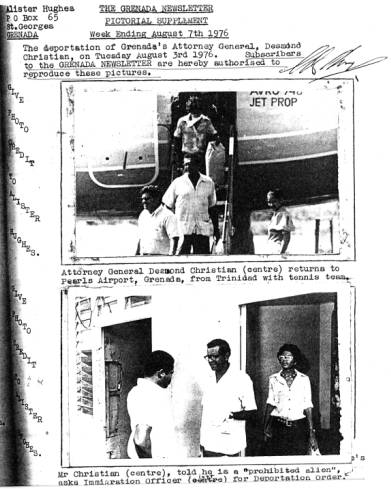
Selection of news items, and excerpts chosen were often sufficient to indicate the true sentiments of the Newsletter's editors. Immediately after Gairy's overthrow, in 1979, in an article headlined GAIRY'S WITCHCRAFT ROOM, the Newsletter detailed objects found at Gairy's official Mt Royal residence: crucifixes, various powders, statues, robes, capes; names and excerpts from various books found, suggesting witchcraft, the study of UFOs: one of Gairy's latter-day fixations, which had been highlighted in his disreputable and tarnishing speech before the United Nations. The lengthy article also exposed his notoriously ludicrous list of enemies "May God help me Eric Matthew Gairy to overcome these enemies". The list was headed by Gairy's own Leader of the Senate, Derek Knight, and included Alister Hughes, himself.10 There was no subtlety in this round of the age-old vendetta between Hughes and Gairy!
In spite of their commitment to being factual, Grenada's political environment of the Gairy and PRG regimes led to several reports that were widely rumoured but difficult to confirm.
Examples include the Newsletter's persistent reports on the disappearance of Police Inspector Iri Bishop from Grenada's Central Police Station in December 1978. "To date, . . . whereabouts of Police Inspector Iri Bishop are still unknown . . . . Today is the 59th day that he is missing." Their reports includes a verbatim interview with the uncooperative Acting Police Commissioner on this matter.11 And later, the statement "A persistent unconfirmed report is that Inspector Bishop's disappearance is connected with a burglary at a St George's department store last October. According to the report, Inspector Bishop had information linking certain known criminals, former members of the state-paid Mongoose Gang, with the robbery. It is said that these criminals may have information about the disappearance."12
On the other hand, in spite of the Grenada Newsletter's editors likely concurrence with the overwhelming support throughout Grenada for the end of the Gairy regime by the People's Revolutionary Government's armed take-over of March 13, 1979, the Grenada Newsletter of March 17, 1979 merely informed its readers that "A revolutionary army led by New Jewel Movement leader, Mr. Maurice Bishop, 34, staged a successful military coup and has taken over the Government of Grenada." No emotion in the report! This statement was followed by detailed reporting of the coup; reporting of local radio announcements and broadcasts by the PRG as well as from Gairy's Cabinet Members and associates. Clear attempts at balanced reporting.
But a mere 3 weeks into the Revolution their coverage of the PRG quickly indicated problems in paradise. "The Cuban cargo ship 'Matanzas' berthed . . . with what is believed to be a large shipment of arms and ammunition for the government." Grenada Newsletter gives in-depth information on the dimensions of the cases that were unloaded from the ship, the movements at the port under cover of an extended curfew, movement of trucks to the Fort as well as across the island to Grenville.13 These were not hard facts. But detailed circumstantial evidence to back widely believed concerns and rumours.
Though the editors of the Newsletter were often unable to fulfill their stated 'factual' objective, the overall view reaching Caribbean media houses and their readership was that of reliable and credible reports. In an interview with Sir Fred Gollop of Barbados' Nation newspaper, he spoke of the importance in the mid '70's of his fledgling newspaper publishing Alister Hughes' column on Grenada events to increase the Nation's credibility with their own readership.14 Again, Alister Hughes's UWI citation of 1990 affirms him as 'the sole authoritative voice to which the world has turned for news of events in Grenada'.15
In keeping with their founding principles, and upheld throughout its 21 years, of publication, Grenada Newsletter was only available by subscription. At no time did thea Newsletter appear on the streets of Grenada, or anywhere else. In addition, there were no advertisements: it was never to be dependent on commercial interest, influence or consideration. Conversely, withdrawal of commercial support was never a concern. The Newsletter was clearly not conceived as a lucrative source of retirement income nor as a profitable venture from a monetary standpoint! The Newsletter's subscription cost $15.00 E.C (about $5.50 U.S.) per issue, postage paid. As the list of subscribers expanded, in defiance of capitalistic gain or business savvy, the cost per issue fell to $10.00 E.C. ($3.50 US)!
Subscriptions peaked early, at the end of the Gairy era, at about 200 subscribers, and remained steady for the years ahead. More important than the volume of subscriptions was the weight of persons and institutions that it reached. Its readership was partly local, within Grenada, but mainly overseas. It extended to several persons and institutions with interest in Grenada's and the Caribbean's economic and political development, and included Trade Missions, High Commissions and Embassies. For a short time during the PRG, Phyllis Coard was a subscriber. The Newsletter was mailed within Grenada, throughout the Caribbean as well as to Miami, New York, Toronto, London, and as far a field as France, Holland and Australia.
Unwittingly, and in hindsight, these decisions proved to be the Grenada Newsletter's greatest defense against threats to press freedom. Threats of censure, closure, arrest and imprisonment of its producers/editors.
The first 10 years of the Newsletter, 1973 - 1983 were troubling years for press freedom in Grenada.
The West Indian newspaper, established in 1915 by TA Marryshow and JB Renwick was a proud symbol of press freedom and West Indian nationalism. After over 50 years of proudly defending these principles, the newspaper was sold by Marryshow's aging partner, under duress, to Gairy's government. It then became the mouthpiece for Gairy's regime. In spite of controlling this dominant source of media, mounting resistance, fueled by consistent opposition by the Torchlight and, after 1973, by the more militant and dynamic Jewel news-sheet called for action, from Gairy's viewpoint.
The Newspaper (Amendment) Act, 1975 required that all newspapers deposit $20,000 in cash with the Accountant General. Earlier legislation had placed the bond at $1,000, "to be drawn against in order to satisfy any judgement in Grenada for libel."16 The 1975 Amendment was a 2,000% increase, in one fell swoop!
Immediately after this Amendment came into force, the twice-weekly Torchlight ceased publication for 2 months. The Jewel attempted to continue, in spite of confrontations between the newspaper vendors and the Police. Several arrests were made. Copies of the Trinidad Express were also seized by Police.17 Put under this level of pressure, the only chance of resumption of the Torchlight was a financial bailout offered by the Trinidad Express, whose stated intention was the preservation of Caribbean press freedom. The Jewel's resolve to continue publication in spite of this legislation, and for the rest of the Gairy era meant that every week, in guerrilla fashion, they published under a new name.
In spite of the contentious relationship between Gairy and Alister Hughes for over 2 decades, the Grenada Newsletter was exempted from this bond. Written assurance from Grenada's Commissioner of Police informed the Newsletter that they were "not at present caught by the Newspaper (Amendment) Act." There is reason to conclude that this decision by Gairy's administration reflected their lack of knowledge of the extent of the Newsletter's readership and its impact, even after 2 years of publication. Its distribution by mailed subscription, and mainly overseas, may have provided a level of protection and invisibility from an otherwise hostile administration.
The story of the start of the Grenada Voice tells yet another tale of the Grenada Newsletter's peculiar and unexpected survival. The recounting requires some historical detail to place it in proper context. Within weeks of the closure of the Torchlight newspaper by the PRG in October 1979, the Newspaper (Amendment) Law, 1979 was passed. By this law, no Grenadian was allowed to hold more than 4% capital in a newspaper or related business.
2 years later, on June 12, 1981 carefully observing all provisions of that Law, the first issue of Grenada Voice newspaper hit Grenada's streets. The Grenada Newsletter announced its start. "A new independent newspaper went on sale in Grenada on June 12. . . and is called the Grenada Voice. . . There has been no independent newspaper in the State since October 1979 when the PRG closed the Torchlight."18 It gave details of Grenada Voice's intent. "We have no axe to grind except the axe of the people who want a medium of free expression."19 Its 26 shareholders each held less than 4% share capital, and these included company directors, lawyers, housewives, a butcher, a trade unionist and a journalist, Grenada Newsletter's Alister Hughes.
The PRG reaction was swift. One week later, June 19, on the eve of publication of the second issue of Grenada Voice the PRG passed the Newspaper (Publications) Law 1981, which made illegal, publication of all newspapers "save as is permitted by this Law". It also stated that the Law was "deemed to have come into effect on the 16th June, 1981", in other words, retroactively. Immediately, on June 19, three of its shareholders, were arrested and taken in for questioning "on suspicion of being involved in printing subversive material"; documents and equipment were seized; cars were seized; telephones of several shareholders were disconnected; houses were searched.
Prime Minister Bishop in a Heroes Day address, that same day, informed Grenadians of the arrests, dubbing the shareholders of the Grenada Voice "unpatriotic scum .....looked after by the CIA" They were "determined to look for trouble, ...they are going to get it.... If the parasites and puppets play with fire, then the fire will burn them.... There is a revolutionary legality and they will have to abide by the Laws of the Revolution." He made pointed reference to Hughes as "a man who has sunk lower and lower over the years".20 Following the rally, about 60 young people staged a vigil outside Hughes' house, drumming and chanting: "If you play with fire, fire will burn you."21
Alister Hughes, the only journalist of the 26 shareholders, was neither arrested, nor detained. From June 19 and in the following weeks the level of harassment and intimidation was, however, intense. Newsletter draft papers and several other papers were seized; Mrs Hughes' handbag was frequently searched; their car was seized; telephone disconnected; their home and place of business was under 24 hour surveillance; all persons entering and leaving their premises were searched.
Concerned about ensuring their own legality in the increasingly more hostile environment, the Hughes sought clarification from the Government. Within 2 weeks of announcement of the Law, they received assurance from Grenada's Attorney General that the publication of the Grenada Newsletter was not "in contravention of the ....Law..."! Provision 4 of the Law stated:
This provision seemed to be crafted to exempt the Grenada Newsletter from closure. The definition of 'continuous' in (2) in particular, given the fact that, because of the constraints of limited staffing, there were several instances when the Grenada Newsletter was not able to be published for weeks on end. On the other hand, Alister Hughes' stated involvement in the Grenada Voice and PRG's harassment of himself and Cynthia Hughes did not suggest that they were in any way favoured by the regime.
This conflict seems to suggest concern on the part of the PRG of the likely international repercussions to the PRG administration of closing the Grenada Newsletter or detention of its editors.
Within 3 weeks of the closure of the Grenada Voice, the PRG detained 3 of the Grenada Voice's shareholders: Lloyd Noel, who had been PRG's Acting Attorney General up to 1980; barrister, Tillman Thomas; and businessman, Leslie Pierre. They remained in jail for the rest of the PRG's rule, and were only released after the US intervention in 1983. Announcing the detentions, Prime Minister Bishop again linked the Grenada Voice to the CIA, and the links of unnamed persons with international media houses bent on undermining the PRG: "...our people have to put up with the fact that every single day reports leave our country being sent out by those who represent the CANA, the UPI, the AP, and the AFP. People who have long since abandoned all regard for truth and facts."
That same month, July 1981, a travel ban was placed on Alister Hughes, effectively preventing him from attending a Caribbean Press Council Executive meeting in Trinidad. The ban was placed under the pretext of investigation of his tax records. In spite of the persistent harrying, at no point were himself nor his wife and partner arrested or detained. For the next 10 months, the Hughes operated without a car; for 11 months without telephone service and with resumption it was assumed to be monitored. Guards were stationed outside their home and place of business, and they were tailed whenever they left their premises.
The Grenada Newsletter continued to witness the events in Grenada, as they unfolded throughout those history making years. Living and working in a small city, in a small island, where privacy was and still is at a premium, where persons were regularly branded as enemies of the Revolution and detained, inevitably visits to the Hughes' home and office became almost taboo for friends and associates who increasingly feared for their own safety.
The initial 2 pages and 500 words of the Grenada Newsletter quickly expanded to 5, 10, 20, often over 30 pages of news per issue. This was a time of breaking news, every week. Sometimes every day! Events of the times created a focus on political coverage, but not exclusive of other valuable news and information. The Newsletter reported on Industrial Relations, trade statistics, highlights of corporate developments. There were nutmeg, banana, cocoa industry statistics and highlights within these sectors. Cruise ship and other tourism information were regularly included. Reporting was comprehensive and detailed. There were frequent updates of politically related arrests in the Gairy era, political detainees and reports from the PRG's Detention Tribunal, and progress of the individual hearings.
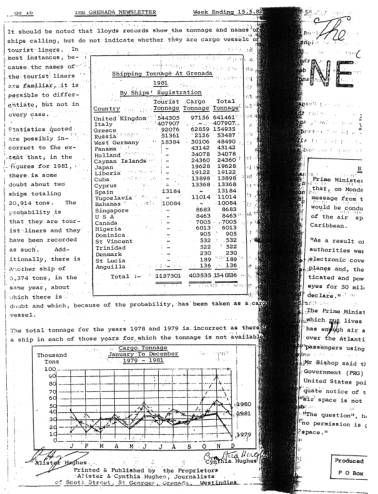
Headlines of a Grenada Newsletter, picked at random in June 1983 read as follows:
For many years, an Alphabetical Index and a Chronological Catalogue of Events were included at each year end. The first page contained an Explanatory Note for use of the Index and Catalogue. The 1981 Catalogue ran to 33 pages. The producers seemed to be fiercely aware of the research and historical value of their work. Each issue was carefully referenced by date, page, issue and volume, making the Newsletter 'user-friendly' to the potential readers, long before the computer age popularized that term.
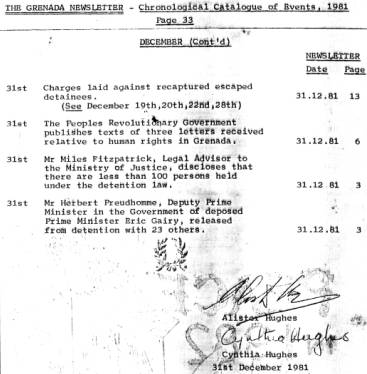
Even the issue of October 19 1983 carried additional news stories
And then
That issue ends with the short news item under the head-line
George Brizan, in his "Grenada, Island of Conflict" aptly refers to this period as "The Revolution Self-Destructs". It was only at this time of total chaos, that the PRG were forced into/found it necessary to silence Alister Hughes and his Newsletter, but in doing so, Alister Hughes became the news. "By persecuting the reporter, those responsible ensured that he became the news; the messenger, ... became the message."24
From 19 October to 26 November, 1983 no Newsletter was or could be produced! An insertion reads "The printers and publishers of Grenada Newsletter have faced considerable difficulty in bringing the publication up to date... after the traumatic events of October.... because of our presence in the island... our intimate knowledge of the situation, and our sources of information, we have become VIP's Very Interviewed Persons."25
The following year, 1984, Columbia University's Maria Moors Award for outstanding journalistic service was conferred on Alister and Cynthia Hughes, editors and producers of the Grenada Newsletter. This was the first time that Award had ever been conferred on a husband and wife team.
Closing the final hearing of the 19 accused in the Maurice Bishop Trial, Sir Frederick Smith, President of the Court of Appeal described the hearing as historic and important, generating world-wide interest, perhaps unparalleled in the British Commonwealth. "Our judgements will be read closely in London, Australia, India, Germany, America, and elsewhere. I may be pushing up daisies by that time and will not hear the criticisms."26 The entire trial, from Preliminary Enquiry in June 1984 to the Appeal Court judgement in July 1991, exceeded 7 years. The Grenada Newsletter witnessed every sitting, and faithfully recorded the proceedings of this dramatic Trial.
The best of the Caribbean's advocacy and jurisprudence were brought to bear in the prosecution, defence and judiciary. The chilling and revealing evidence. The test of wits and wisdom as strategies and counter-positions were taken by the accused, their lawyers and the prosecution. Disruption of the proceedings by the innovative and effectively distracting clapping and stamping of the accused, which eventually created concerns, voiced by the Defence Team, regarding the legality of their conviction in absentia; the questioned legality of the entire Trial; the dramatic withdrawal of the defence lawyers and resumption of defence in the Appeal Court; the legal sparring of prosecution Karl Hudson-Phillips Q.C, and Lead Defence Ian Ramsay, to the point of Ramsay facing contempt charges.
The learned and experienced President of the Appeal Courts commented: "I have never before experienced such diligent and thorough research . . . every legal stone was turned in presenting the grounds of Appeal."27
The Court began delivery of its judgement on July 10, 1991. The judges, Sir Frederick Smith, Rex McKay and Time Kendall took turns delivering the judgement over 3 days. The Appeal judgement upheld that of the Trial.
Throughout the trial, in addition to reporting on proceedings, Grenada Newsletter advised its readership of legal and constitutional issues pertinent to the Trial as well as testing the temperature of Grenada's public opinion. "An informal spot-check of opinion statewide indicates little sympathy." "These persons had no mercy when they were in power. . . The Trial and Appeal have cost Grenada a large sum of money.... to do anything now but carry out the executions will increase the cost by the amount required to house and feed the convicted persons."28
The suspense and tension of the final verdict and count down to the appointed date for hanging is felt in the issues of July and August 1991, followed by the unexpected and still unexplained commuting of the sentences by Prime Minister Braithwaite. The lack of agreement of Grenada Newsletter's editor is clearly noted. The August 24 headline reads "LIFE SENTENCES FOR BISHOP'S KILLERS".29
In December 1989, after a very short illness, Cynthia Hughes passed away. Alister Hughes continued for the next 5 years as sole editor and producer. In January 1994, he informed his readers of his intention to end the Grenada Newsletter, and did so, 4 months later. At age 75, his years of full time journalism came to an end.
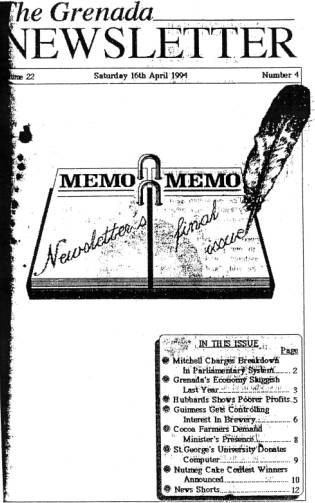
But, 8 years later, at 83, deterred by neither age nor ill-health, Alister Hughes' legacy is still in progress. In 1997, at 78, he remarried. To quote Ken Gordon, he is "very fortunate and clearly possessed of powerful hidden talents. In a world where finding the ideal partner is extraordinarily difficult, he has found two, with a success ratio of 100%.30 In addition, he is presently writing a "History of Grenada 1950 - 2000". But his means of recording has changed dramatically since his Grenada Newsletter days. Far from the old Hermes manual typewriter, the testimony is now being produced on a state of the art laptop computer, which also keeps him in touch with his newly created Grenadian History Web-site .
Grenada Newsletter is a record of 21 years of intense journalism , documenting the traumatic birth of the Grenadian nation, with breaking news and international interest far beyond expectation based on Grenada's size and population. Times of drama and adventure. With civil disobedience; mass demonstrations; island wide strikes; a military coup; bold, ground-breaking initiatives under revolutionary government; heady ideology; detentions; threats to press freedom and civil liberties; fights to retain and regain press freedom and civil liberties; murder by firing squad; massacre of civilians; warfare; military intervention by foreign forces; arrest, imprisonment of not 1 nor 2 but 19 political prisoners; 7 years of court room drama. Finally, regrouping and reorganizing in the quest for return to democratic government. Story book stuff, at its best. Material for an adventure novel. The dream of every young intrepid journalist . Great in the re-telling. Not for the faint-hearted or the weary. But daunting, frightening and down-right dangerous!
An intriguing aspect of this saga is the fact that Cynthia and Alister Hughes were not young adventure seekers. They began full time journalism in their mid 50s, when their contemporaries would have been preparing to 'wind down' into peaceful retirement. In large part, the determination, resolve and resilience that kept Grenada Newsletter in circulation for 21 years through testing times had their genesis in what had happened in the 50 years before! Suffice it to say that the full story of those years is material for a saga in itself.
In 1974 those treacherous and testing times caused them to flee to Carriacou. 4 months later, as the boat on which they travelled brought them back into St George's harbour, Hughes claims he made his resolve never in life again to run away!31
The Newsletter was more than a job. Instead it formed a hub, a centre for expression of their passion and conviction. A passion for Grenada and nationhood. Glimpses of these can be gleaned from occasional insertions which they placed into the Newsletter.
'Milestones' informed their readers of moments in history, relevant in some way, to Grenada and the Caribbean.
'Footprints' were little snippets of Grenada's indigenous language from their private research, which they called Grenadianese.
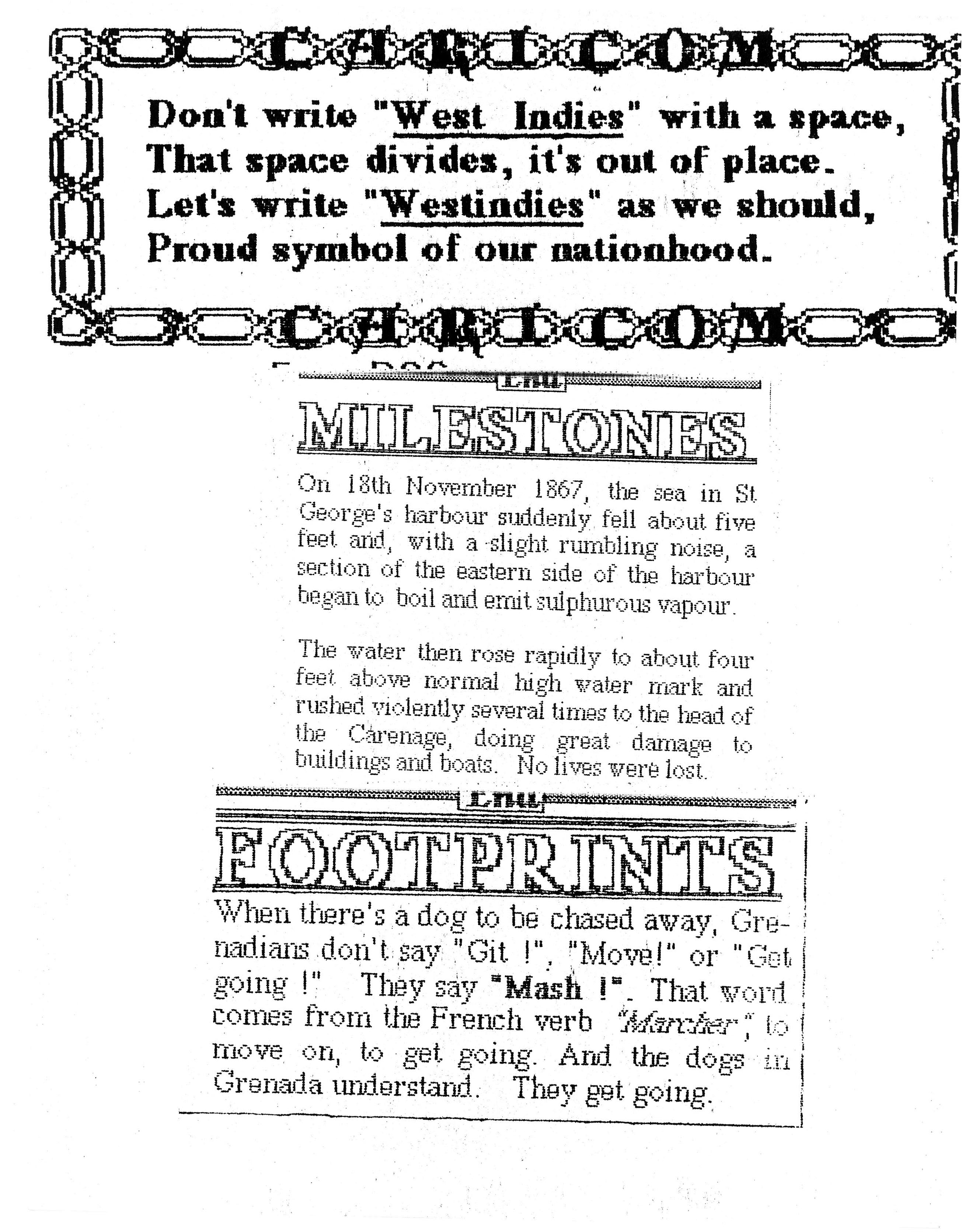
The 'Westindian' poem was the most frequent insertion, reflecting the editors' passion for their Caribbean nationhood. At the end of his journalistic career, Alister Hughes was offered the 'distinction' of being conferred with the colonial honour, the Commander of the British Empire. He was so vehement in his refusal, he mistakenly sent back the letter of offer along with his reply!32 The 1990 Honorary Doctor of Laws Degree from his own University of the West Indies, he regards as his greatest public honour!
Grenada Newsletter was not a sole venture. From inception, the Newsletter was a joint partnership of Alister and Cynthia Hughes. Ken Gordon refers to "Cynthia, his outstanding wife of 46 years, who doubled as his friend and inseparable partner up to the time of her death in 1989."33 It was the synergy of the two which made for success. Alister Hughes refers to her as not beside him, but "she was always in front of me!" In 1981, at the time of the closure of the Grenada Voice, and allegations of their CIA connections, her feisty retort was "Yes! We are CIA: Christians in Action!"34 In spite of their frequent inclusions of Milestones and Footprints and the Westindian poem, their professionalism precluded any personal information, except information which was directly relevant. Not even Hughes' Honorary Doctorate was recorded. They made one exception: the birth announcements of their grandchildren!
The headline of Grenada Newsletter of 11 August, 1990 reads "TROUBLE IN TRINIDAD" : Gunmen hold Prime Minister Robinson Hostage". An insert reads "Newsletter's editor flew into Trinidad's Piarco Airport at 6.00p.m. on Friday 27th July, just when the attempted armed take-over of the Government was launched. He was on his way to his mother's 94th birthday party but he never got there. Trouble in Trinidad is a condensation of his coverage of the crisis supplemented by interviews and press reports."35 A stroke of luck for a journalist! Even more so was the co-incidence of AP's Trinidad correspondent being out of Trinidad that week, and therefore not available to cover breaking news of Abu Bakr's Muslimeen attempted take-over of Trinidad's government. Alister Hughes, AP's Grenada correspondent was on the spot to fill in! In fact the entire saga of the Grenada Newsletter was a stroke of luck: Alister and Cynthia Hughes were in the right place at the right time, in 1973, and on. With their experience, maturity and passion to support and sustain them in spite of the challenges All the ingredients necessary and vital for the success of that venture.
Grenada Newsletter, all 20 of its 21 volumes, adds richness to Grenada's historical legacy. It provides a comprehensive primary source document of the most critical period of Grenada's 20th century history. 21 years of a traumatic and exhausting birth of the Grenadian nation.
All historians and researchers need reference to original source documents as they search to find out and understand the past. Researchers into our history have depended in large measure on official records, but the works of earlier writers such as Du Tertre, Père Labat, Brian Edwards have proven invaluable for embellishing their understanding and providing those personal insights into what life was really like, in the past.
The Grenada Newsletter is equal and surpasses all of these sources. Because of Its breadth of subject matter and detail of what was recorded. Because of the critical period it sets on record. Because the telling was recorded by one of its own people, and a true Grenadian historian.
2 Grenada Newsletter 9 February, 1991.
3 Brizan, George, Grenada: Island of Conflict, Macmillan 1998.
4 Presentation of Award by Ken Gordon to Alister Hughes. Grenada Media Conference, May 2001.
14 Interview with Sir Fred Gollop by GGW. May 2001.
15 Citation for conferment of Honorary Doctor of Laws, UWI, Nov 1990.
16 The Newspaper (Amendment) Act No 9 1975.
20 Address at Heroes Day Rally June 19 1981 Maurice Bishop Selected Speeches 1979 - 1981 Casa de las Americas (no date).
22 People's Law No 18 of 1981 (Gazetted 19th July, 1981).
24 Alister Hughes Citation UWI November 1990.
30 Presentation of Award by Ken Gordon to Alister Hughes. Grenada Media Conference, May 2001.
31 Interviews with Alister Hughes by GGW, 2001.
32 Interviews with Alister Hughes by GGW, 2001.
33 Presentation of Award by Ken Gordon to Alister Hughes. Grenada Media Conference, May 2001.
34 Interviews with Alister Hughes by GGW, 2001.
© Gillian Glean Walker, 2004.
 HTML last
revised 27th August, 2004.
HTML last
revised 27th August, 2004.
Return to Conference papers.